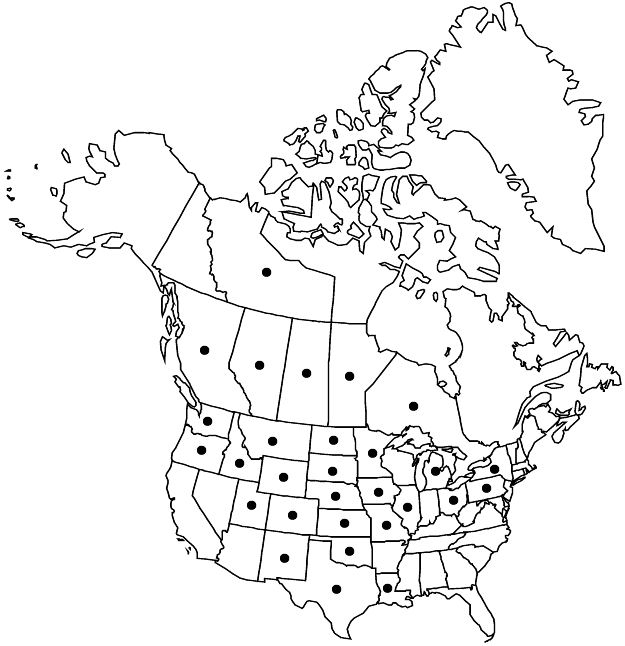Difference between revisions of "Potentilla supina"
Sp. Pl. 1: 497. 1753.
FNA>Volume Importer |
RevisionBot (talk | contribs) m (Bot: Adding category Revised Since Print) |
||
| (5 intermediate revisions by 3 users not shown) | |||
| Line 9: | Line 9: | ||
|special_status={{Treatment/ID/Special_status | |special_status={{Treatment/ID/Special_status | ||
|code=F | |code=F | ||
| − | |label= | + | |label=Illustrated |
}} | }} | ||
|basionyms= | |basionyms= | ||
| Line 23: | Line 23: | ||
-->{{Treatment/Body | -->{{Treatment/Body | ||
| − | |distribution= | + | |distribution=Alta.;B.C.;Man.;N.W.T.;Ont.;Sask.;Colo.;Idaho;Ill.;Iowa;Kans.;La.;Mich.;Minn.;Mo.;Mont.;N.Dak.;N.Mex.;N.Y.;Nebr.;Ohio;Okla.;Oreg.;Pa.;S.Dak.;Tex.;Utah;Wash.;Wyo.;Mexico;Eurasia;Africa;introduced in Australia. |
|discussion=<p>Subspecies 7 (1 in the flora).</p><!-- | |discussion=<p>Subspecies 7 (1 in the flora).</p><!-- | ||
--><p>The status of <i>Potentilla supina</i> in North America is open to question, given the otherwise Eurasian and northern African distribution of the species and ease of transport by migratory waterfowl. Although North American material has commonly been treated as a distinct species (<i>P. paradoxa</i>), E. Hultén and M. Fries (1986) went so far as to consider <i>P. supina</i> introduced in North America. The use of subspecies within a broadly defined <i>P. supina</i> follows J. Soják (1987, 1993) and is also adopted by A. Kurtto et al. (in J. Jalas et al. 1972+, vol. 13).</p> | --><p>The status of <i>Potentilla supina</i> in North America is open to question, given the otherwise Eurasian and northern African distribution of the species and ease of transport by migratory waterfowl. Although North American material has commonly been treated as a distinct species (<i>P. paradoxa</i>), E. Hultén and M. Fries (1986) went so far as to consider <i>P. supina</i> introduced in North America. The use of subspecies within a broadly defined <i>P. supina</i> follows J. Soják (1987, 1993) and is also adopted by A. Kurtto et al. (in J. Jalas et al. 1972+, vol. 13).</p> | ||
| Line 34: | Line 34: | ||
-->{{#Taxon: | -->{{#Taxon: | ||
name=Potentilla supina | name=Potentilla supina | ||
| − | |||
|authority=Linnaeus | |authority=Linnaeus | ||
|rank=species | |rank=species | ||
| Line 41: | Line 40: | ||
|basionyms= | |basionyms= | ||
|family=Rosaceae | |family=Rosaceae | ||
| − | |distribution= | + | |distribution=Alta.;B.C.;Man.;N.W.T.;Ont.;Sask.;Colo.;Idaho;Ill.;Iowa;Kans.;La.;Mich.;Minn.;Mo.;Mont.;N.Dak.;N.Mex.;N.Y.;Nebr.;Ohio;Okla.;Oreg.;Pa.;S.Dak.;Tex.;Utah;Wash.;Wyo.;Mexico;Eurasia;Africa;introduced in Australia. |
|reference=None | |reference=None | ||
|publication title=Sp. Pl. | |publication title=Sp. Pl. | ||
|publication year=1753 | |publication year=1753 | ||
| − | |special status= | + | |special status=Illustrated |
| − | |source xml=https:// | + | |source xml=https://bitbucket.org/aafc-mbb/fna-data-curation/src/2e0870ddd59836b60bcf96646a41e87ea5a5943a/coarse_grained_fna_xml/V9/V9_199.xml |
|subfamily=Rosaceae subfam. Rosoideae | |subfamily=Rosaceae subfam. Rosoideae | ||
|tribe=Rosaceae tribe Potentilleae | |tribe=Rosaceae tribe Potentilleae | ||
| Line 54: | Line 53: | ||
}}<!-- | }}<!-- | ||
| − | -->[[Category:Treatment]][[Category:Potentilla sect. Rivales]] | + | --> |
| + | |||
| + | [[Category:Treatment]] | ||
| + | [[Category:Potentilla sect. Rivales]] | ||
| + | [[Category:Revised Since Print]] | ||
Latest revision as of 17:19, 6 November 2020
Distribution

Alta., B.C., Man., N.W.T., Ont., Sask., Colo., Idaho, Ill., Iowa, Kans., La., Mich., Minn., Mo., Mont., N.Dak., N.Mex., N.Y., Nebr., Ohio, Okla., Oreg., Pa., S.Dak., Tex., Utah, Wash., Wyo., Mexico, Eurasia, Africa, introduced in Australia.
Discussion
Subspecies 7 (1 in the flora).
The status of Potentilla supina in North America is open to question, given the otherwise Eurasian and northern African distribution of the species and ease of transport by migratory waterfowl. Although North American material has commonly been treated as a distinct species (P. paradoxa), E. Hultén and M. Fries (1986) went so far as to consider P. supina introduced in North America. The use of subspecies within a broadly defined P. supina follows J. Soják (1987, 1993) and is also adopted by A. Kurtto et al. (in J. Jalas et al. 1972+, vol. 13).
Selected References
None.